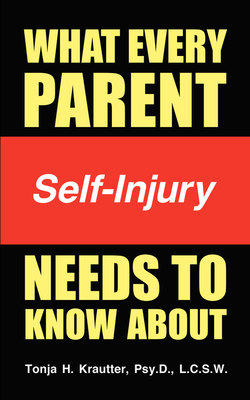Читать книгу What Every Parent Needs to Know About Self-Injury - Tonja Krautter - Страница 4
На сайте Литреса книга снята с продажи.
Who Self-Injures?
ОглавлениеAlthough study estimates vary, it is generally believed that 13% to 25% of adolescents and young adults surveyed in schools have some history of self-injury. (Rodham & Hawton, 2009). While many of these individuals self-injure only once or twice and then stop, others begin to practice the behavior regularly. Studies of college populations have determined that roughly 6% of college students actively and habitually practice self-injury. While it is likely that this same 6% applies to adolescents as a group, middle schools are likely to have a higher percentage of students practicing self-injury, as the behavior most often begins between the ages of 14 and 16. (Whitlock, Eckenrode, et al., 2006; Gollust, Eisenberg, & Golberstein, 2008). However, individuals also begin injuring in childhood and as adults.
People of all age, gender, sexual orientation, and race self-harm. While self-injury is prevalent in both males and females, it is typically more visible among females. (Whitlock, Muehlenkamp, et al., 2009). Additionally, young people identifying as bisexual, or questioning are considered at higher risk than their heterosexual or homosexual peers. (Whitlock, Eckenrode, et al., 2006; Whitlock, Muehlenkamp, et al., 2009). Individuals from a wide variety of geographic, socioeconomic, and cultural backgrounds participate in this deliberate, repetitive, and destructive behavior.
The reasons behind the need to self-injure are complex and often neglected or misunderstood. As a result, the behavior is frequently kept secret, which suggests that the number of reported cases is significantly lower than the number of actual cases in our country. Most individuals do not willingly seek treatment. If they do enter treatment, it is usually because a loved one insists on intervention. The person most likely to enter treatment is from a middle-to-upper-class family, with average-to-high intelligence and low self-esteem.
Nadia fits this description perfectly. She is 17 years old, bright, and from an upper-class family. She did not want to get help for self-harm. Nadia’s parents “forced her into treatment.” She kept it a secret for several years before they discovered cuts on her arm. Nadia was extremely angry when she entered therapy. She believed that her parents were making “a big deal out of nothing,” and had no desire to share her thoughts and feelings with a complete stranger. She acknowledged that she rarely shared her thoughts and feelings even with people she was close to in her life.
However, through the course of treatment, Nadia began to open up. She admitted that she often felt empty inside. In a therapeutic journal assignment, she wrote, “Sometimes I perceive my world in shades of grey, like a black and white TV show. When I don’t see color, when I feel grey, I feel no emotion other than sadness. Yet I don’t feel sad enough to cry. It is a superficial sadness that tenaciously covers my other emotions so that I can’t reach them. When feeling grey, I’m numb to the world around me and I am numb to myself. This is what entices me to cut. I want to see red. I want to see color. I want to feel something.”
It is not uncommon for individuals who self-injure to experience this kind of emptiness, and to use self-harm as a way to experience some sort of feeling. Physical pain helps them to feel alive and not devoid of emotion. Human beings have the ability to feel things deeply. For many individuals who self-harm, seeing blood helps them to feel human.
Many individuals who self-injure report some form of abuse (physical, emotional, or sexual) during their childhood. Van der Kolk, Perry, and Herman (1991) conducted a study of individuals who exhibited cutting behavior. They found that exposure to physical abuse or sexual abuse, physical or emotional neglect, and chaotic family conditions during childhood, latency, and adolescence, were reliable predictors of the amount and the severity of cutting.
Sexual abuse victims were most likely of all to cut. The resulting trauma experienced by the individual can be an underlying cause of self-injurious behavior. This is true for Cathy. She was fifteen and a sophomore in high school when she was brutally raped while on vacation with her family in the Caribbean. Cathy is twenty-two now, and remembers that day as if it were yesterday. Following is one of the poems she wrote to try to make sense of what she was feeling:
